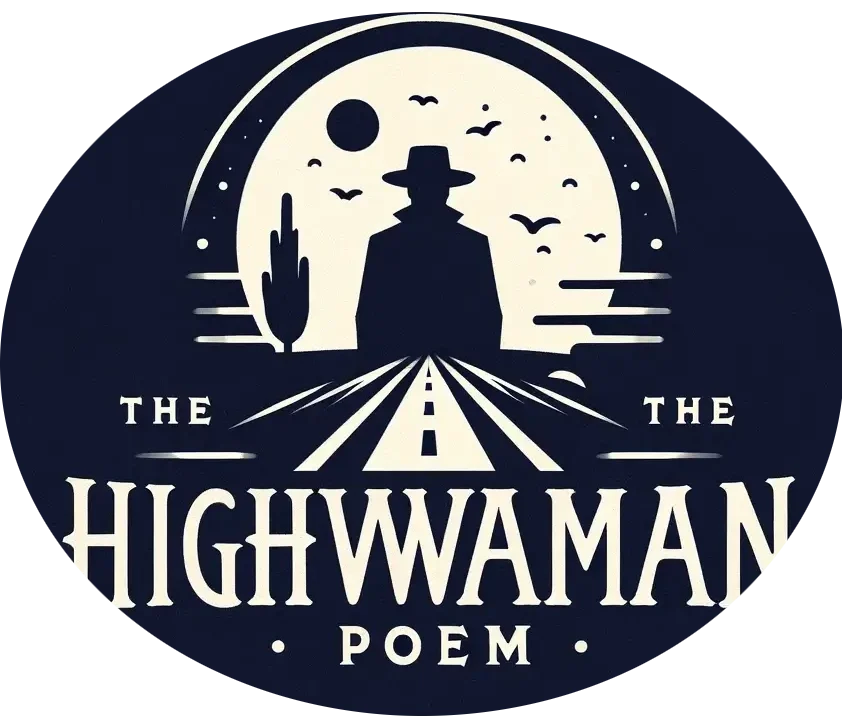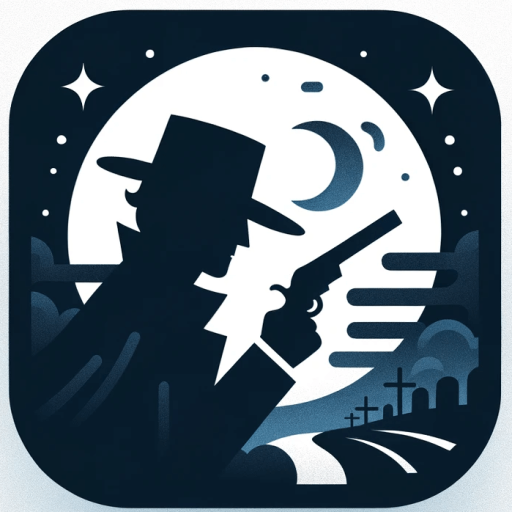The Highwayman poem by Alfred Noyes
Part One
“A daring highwayman and his beloved, Bess, plan a secret rendezvous at the inn, setting the stage for a passionate and suspenseful romance amid the threat of impending danger from the Redcoats.”
I
The wind was a torrent of darkness among the gusty trees,
The moon was a ghostly galleon tossed upon cloudy seas,
The road was a ribbon of moonlight over the purple moor,
And the highwayman came riding— riding—riding—riding
The highwayman came riding, up to the old inn-door.
II
He’d a French cocked-hat on his forehead, a bunch of lace at his chin,
A coat of claret velvet, and breeches of brown doe-skin;
They fitted with never a wrinkle: his boots were up to the thigh!
And he rode with a jewelled twinkle, his pistol butts a-twinkle,
His rapier hilt a-twinkle, under the jewelled sky.
III
Over the cobbles he clattered and clashed in the dark inn-yard.
He tapped with his whip on the shutters, but all was locked and barred.
He whistled a tune to the window, and who should be waiting there
But the landlord’s black-eyed daughter, Bess, the landlord’s daughter,
Plaiting a dark red love-knot into her long black hair.
IV
And dark in the dark old inn-yard a stable-wicket creaked
Where Tim the ostler listened. His face was white and peaked.
His eyes were hollows of madness, his hair like mouldy hay,
But he loved the landlord’s daughter, the landlord’s red-lipped daughter.
Dumb as a dog he listened, and he heard the robber say—
V
“One kiss, my bonny sweetheart, I’m after a prize to-night,
But I shall be back with the yellow gold before the morning light;
Yet, if they press me sharply, and harry me through the day,
Then look for me by moonlight, watch for me by moonlight,
I’ll come to thee by moonlight, though hell should bar the way.”
VI
He rose upright in the stirrups. He scarce could reach her hand,
But she loosened her hair in the casement. His face burnt like a brand
As the black cascade of perfume came tumbling over his breast;
And he kissed its waves in the moonlight, (O, sweet black waves in the moonlight!)
Then he tugged at his rein in the moonlight, and galloped away to the west.
Part two
“Bess sacrifices her life to warn her lover, the highwayman, of the Redcoats’ ambush, leading to a tragic and dramatic climax in their love story.“
VII
He did not come in the dawning. He did not come at noon;
And out of the tawny sunset, before the rise of the moon,
When the road was a gypsy’s ribbon, looping the purple moor,
A red-coat troop came marching—marching—marching
King George’s men came marching, up to the old inn-door.
VIII
They said no word to the landlord. They drank his ale instead.
But they gagged his daughter, and bound her, to the foot of her narrow bed.
Two of them knelt at her casement, with muskets at their side!
There was death at every window; and hell at one dark window;
For Bess could see, through her casement, the road that he would ride.
IX
They had tied her up to attention, with many a sniggering jest.
They had bound a musket beside her, with the muzzle beneath her breast!
“Now, keep good watch!” and they kissed her. She heard the doomed man say—
Look for me by moonlight; watch for me by moonlight;
I’ll come to thee by moonlight, though hell should bar the way!
X
She twisted her hands behind her; but all the knots held good!
She writhed her hands till her fingers were wet with sweat or blood!
They stretched and strained in the darkness, and the hours crawled by like years
Till, now, on the stroke of midnight, cold, on the stroke of midnight,
The tip of one finger touched it! The trigger at least was hers!
XI
The tip of one finger touched it. She strove no more for the rest.
Up, she stood up to attention, with the muzzle beneath her breast.
She would not risk their hearing; she would not strive again;
For the road lay bare in the moonlight; blank and bare in the moonlight;
And the blood of her veins, in the moonlight, throbbed to her love’s refrain.
XII
Tlot-tlot; tlot-tlot! Had they heard it? The horsehoofs ringing clear;
Tlot-tlot; tlot-tlot, in the distance? Were they deaf that they did not hear?
Down the ribbon of moonlight, over the brow of the hill,
The highwayman came riding—riding—riding
The red coats looked to their priming! She stood up, straight and still.
XIII
Tlot-tlot, in the frosty silence! Tlot-tlot, in the echoing night!
Nearer he came and nearer. Her face was like a light.
Her eyes grew wide for a moment; she drew one last deep breath,
Then her finger moved in the moonlight, her musket shattered the moonlight,
Shattered her breast in the moonlight and warned him—with her death.
XIV
He turned. He spurred to the west; he did not know who stood
Bowed, with her head o’er the musket, drenched with her own blood!
Not till the dawn he heard it, and his face grew grey to hear
How Bess, the landlord’s daughter, the landlord’s black-eyed daughter,
Had watched for her love in the moonlight, and died in the darkness there.
XV
Back, he spurred like a madman, shrieking a curse to the sky,
With the white road smoking behind him and his rapier brandished high.
Blood red were his spurs in the golden noon; wine-red was his velvet coat;
When they shot him down on the highway, down like a dog on the highway,
And he lay in his blood on the highway, with a bunch of lace at his throat.
Part three
“On a winter’s night, a mysterious highwayman arrives at an old inn where he seeks the landlord’s daughter, Bess, while the moonlight bathes the scene in intrigue and romance.”
XVI
And still of a winter’s night, they say, when the wind is in the trees,
When the moon is a ghostly galleon tossed upon cloudy seas,
When the road is a ribbon of moonlight over the purple moor,
A highwayman comes riding—riding—riding
A highwayman comes riding, up to the old inn-door.
XVII
Over the cobbles he clatters and clangs in the dark inn-yard.
He taps with his whip on the shutters, but all is locked and barred.
He whistles a tune to the window, and who should be waiting there
But the landlord’s black-eyed daughter, Bess, the landlord’s daughter,
Plaiting a dark red love-knot into her long black hair.
∾ The end ∾
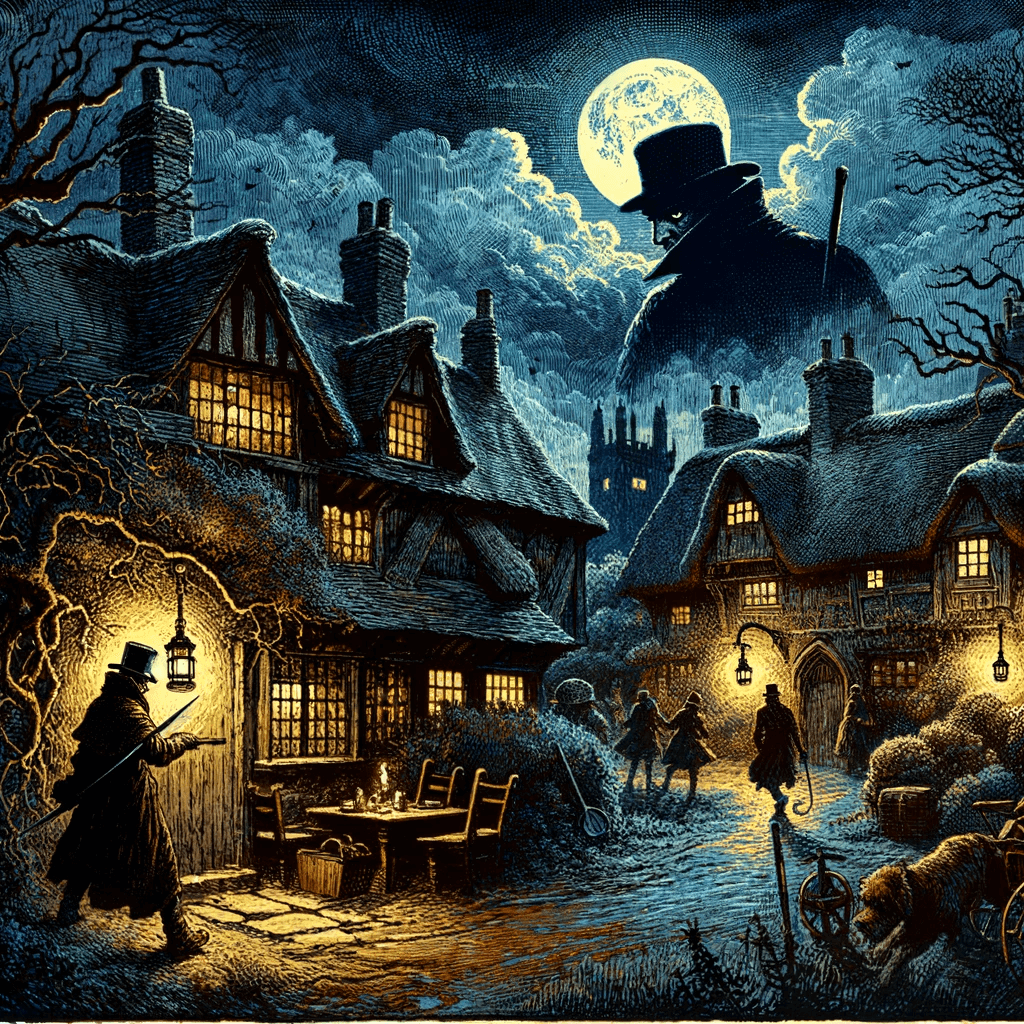
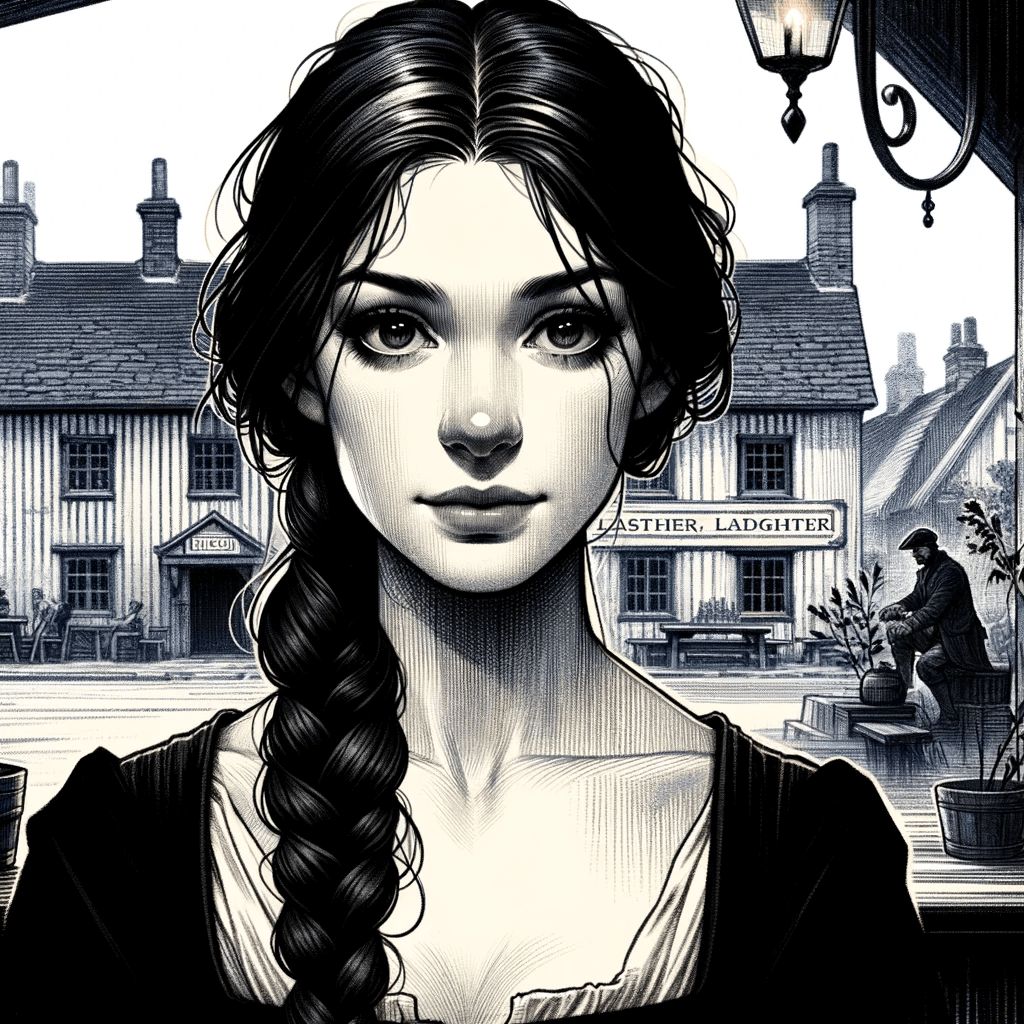
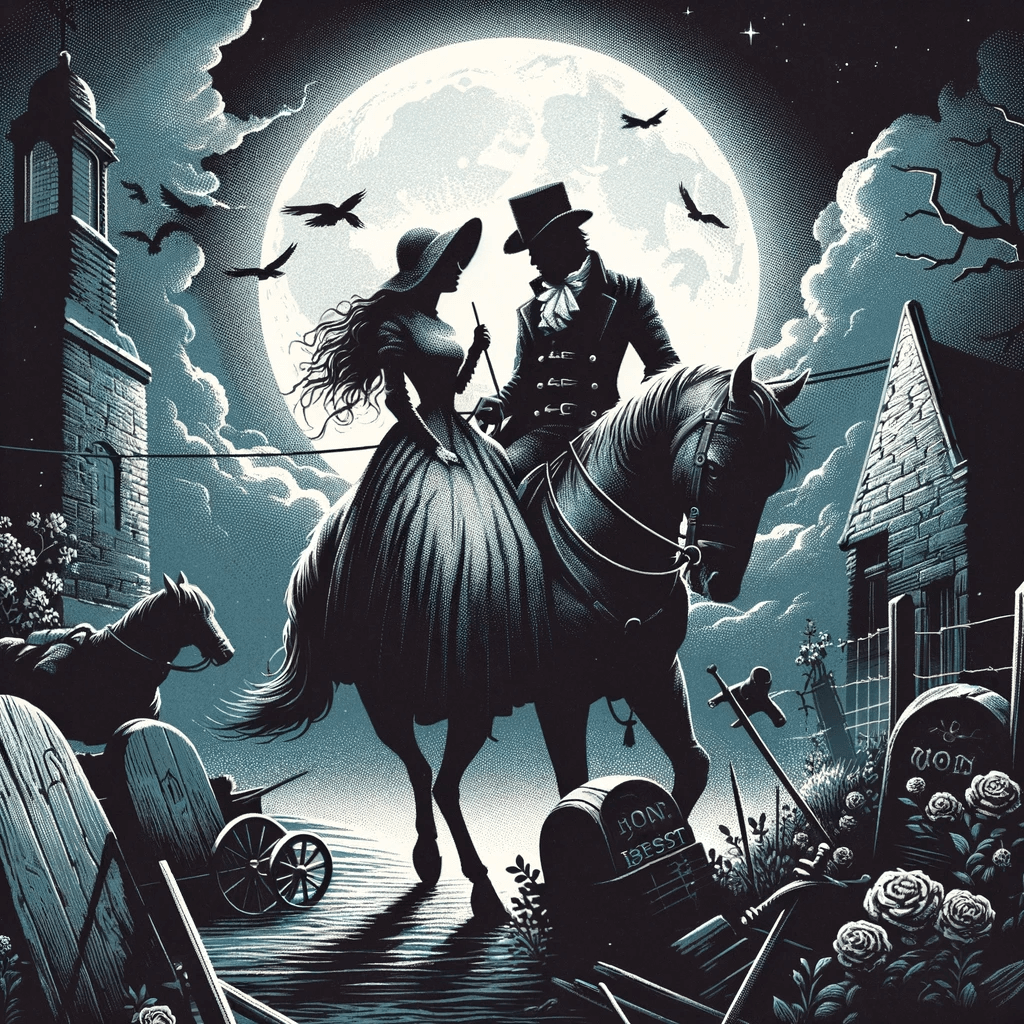
“The Enchanting Tale of Love and Tragedy: A Deep Exploration of Alfred Noyes’ ‘The Highwayman’ Poem”
“The Highwayman” is a narrative poem about a dashing highwayman who robs travelers by night. He falls in love with the landlord’s daughter, Bess, but their love story is marked by tragedy.
The poem is set against the backdrop of a moonlit night, with vivid descriptions of the characters and the landscape, making it feel almost like a movie playing in your mind.
What makes this poem significant in literary history is its masterful storytelling and the way it combines elements of romance, adventure, and tragedy.
Did you know…
“Alright, check this out – before Alfred Noyes became the poetry sensation we know today, he was just a regular kid in Wolverhampton, England. But hold on to your teacups because his family decided, ‘Hey, let’s add a dash of adventure to our lives!’ and packed up for Aberystwyth, Wales. Why, you ask? Well, his dad had a thing for Latin and Greek, and Wales seemed the perfect place. Who knew a love for dead languages could lead to epic poetry?”😉⭐️
Poem Analysis
The narrative style of the poem takes us on a journey, unfolding like a vivid scene from a movie. The words paint pictures in our minds, allowing us to see the wind as a “torrent of darkness” and the moon as a “ghostly galleon.”
These powerful descriptions instantly draw us into the world of the highwayman and his ill-fated love affair.
The structure of the poem is equally captivating. It’s divided into two parts, each with its distinct focus. The first part introduces us to the highwayman, his daring exploits, and his love for Bess. The second part shifts to a darker tone, as it reveals the tragic outcome of their love story. This structure keeps us engaged, wondering what will happen next.
Love is a central theme in “The Highwayman.” The highwayman’s love for Bess is both passionate and romantic. He risks his life to see her, and his promise to return to her by moonlight shows the depth of his feelings.
Bess’s love for the highwayman is equally strong, as she sacrifices her own safety to protect him. However, their love ultimately leads to betrayal and tragedy, highlighting the theme of love’s complexity and the sacrifices it may demand.
Did you know…
Here’s a juicy tidbit: Noyes hit up Exeter College, Oxford, like he was all set for a degree, right? But then, plot twist! He decides, ‘Nah, I’m outta here,’ and ditches the whole degree thing to chase his dream of becoming a literary sensation. Who needs a degree when you’ve got words, right?😉📚
Betrayal is another key theme in the poem. The highwayman is betrayed by the jealous Tim, the ostler, who alerts the authorities about his plans.
Bess, too, faces betrayal as the red-coat soldiers use her as bait to capture the highwayman. This theme underscores the harsh realities of the world they inhabit, where loyalty can be fleeting and trust can be shattered.
Sacrifice is a poignant theme that runs throughout the poem. Bess sacrifices her own safety and, ultimately, her life to warn the highwayman of the impending danger.
The highwayman, in turn, sacrifices his life for love and honor, choosing to face the soldiers rather than abandon his principles. These acts of sacrifice highlight the depth of their love and the tragic consequences it brings.
Alfred Noyes employs various literary devices to enhance the poem’s impact. Metaphor is used to create vivid images, such as comparing the moon to a “ghostly galleon” and the road to a “ribbon of moonlight.” These metaphors add depth and visual richness to the narrative.
Did you know…
Okay, brace yourself for this one: Mr. Noyes wasn’t just any old writer. Nope! He dropped some epic poetry volumes, and one of ’em was ‘The Highwayman’ (you might have heard of it, NBD). People couldn’t get enough of his storytelling skills and poetic wizardry. The dude was basically the Beyoncé of words back in the day!😉📖✨
Alliteration is another device that Noyes skillfully uses, as seen in phrases like “purple moor” and “sweet black waves.” This repetition of consonant sounds not only adds musicality to the poem but also reinforces the imagery and emotions conveyed.
Imagery is a hallmark of “The Highwayman.” Noyes’s descriptive language allows readers to visualize the scenes and characters clearly. Whether it’s the “claret velvet” of the highwayman’s coat or the “red lips” of Bess, the imagery in the poem helps us connect with the story on a sensory level.
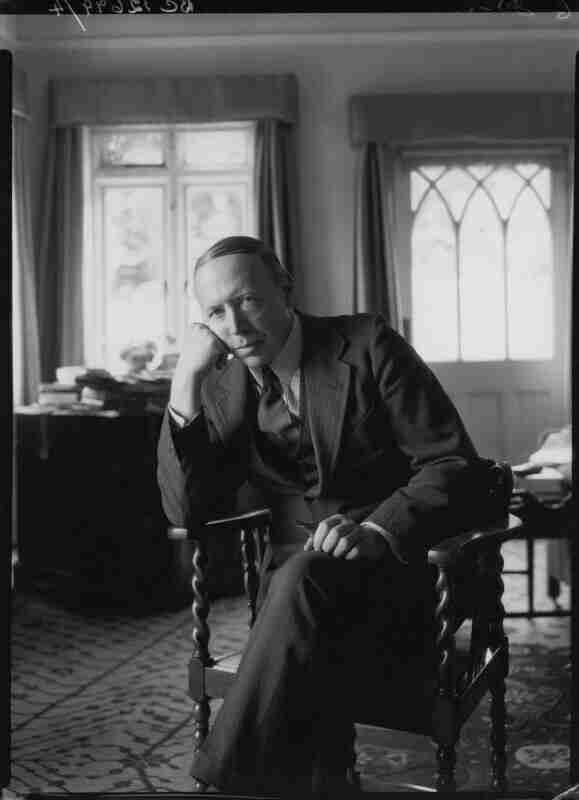
Unique Elements
One remarkable technique is Noyes’s use of vivid and atmospheric settings. He doesn’t merely describe the surroundings; he paints a picture with words. The wind becomes a “torrent of darkness,” the moon a “ghostly galleon,” and the road a “ribbon of moonlight.”
These descriptions create a palpable atmosphere that transports us into the world of the highwayman. It’s as if we’re standing beside him on that moonlit moor, feeling the gusty wind and seeing the cloudy seas. This immersive setting adds depth and dimension to the narrative, making it a truly unforgettable experience.
Did you know…
Time for some relationship drama! Alfred Noyes wasn’t just writing poetry; he was living it. He did the whole ‘I do’ thing not once but twice. First, he hitched up with Garnett Daniels, and then he thought, ‘Hey, why not do it all over again?’ and married Mary Angela Mayne. Oh, and did I mention he had three kids? Talk about a full house!😉💍👨👩👧👦
Character development is another area where “The Highwayman” shines. Noyes uses sparse yet potent details to bring the characters to life. The highwayman, with his “French cocked-hat,” “claret velvet,” and “jewelled twinkle,” is portrayed as a dashing and daring figure.
Bess, the landlord’s daughter, is depicted as both beautiful and brave, willing to sacrifice everything for love. Even Tim, the ostler, is given depth as we glimpse the madness in his eyes and the turmoil of his emotions.
These characters feel real, and their emotions become palpable as the narrative unfolds.
The language and expressions used in the poem are uncommon and rich in imagery. Noyes’s poetic language elevates the story, making it feel like a timeless classic. Phrases like “a bunch of lace at his chin” and “rapier hilt a-twinkle” evoke a sense of elegance and romance.
Alliteration, as in “purple moor” and “sweet black waves,” adds a musical quality to the language, making it a joy to read and hear.
But what truly sets this poem apart is its ability to blend romance with danger seamlessly. It’s a love story wrapped in the cloak of a thrilling adventure. The highwayman’s daring exploits and Bess’s unwavering love create a potent combination that keeps readers on the edge of their seats.
We’re drawn into their world, torn between the excitement of their love and the impending tragedy that looms like a shadow.
The Highwayman’s Tragedy
One of the recurring motifs in romantic poetry is the theme of passionate and all-consuming love. In “The Highwayman,” we witness the highwayman’s love for Bess, which is depicted as intense and unwavering.
His willingness to risk his life and promise to return to her by moonlight showcase the depth of his passion. This theme of love is a hallmark of romantic poetry, where emotions are often portrayed as powerful and overwhelming.
Did you know…
Check this out: Noyes was like the ultimate peacemaker but with a twist. He gave a big thumbs-down to the Boer War, waving his pacifist flag high and proud. But when it came to World Wars, he did a 180 and was all, ‘Go Team Allies!’ Sometimes, even pacifists pick sides when the stakes are sky-high!✌️🕊️🌍
Tragedy is another prevalent motif in the poem, which aligns with the characteristics of tragic poetry. The unfolding of events, marked by betrayal and sacrifice, ultimately leads to a tragic ending.
Bess’s sacrifice and the highwayman’s tragic death underscore the theme of inevitable doom, a common element in tragic literature. It reminds us that love, while beautiful, can also bring about heartbreak and sorrow.
Alfred Noyes’ use of vivid imagery and poetic language creates a sense of immersion for the reader, drawing us into the world of the highwayman and his ill-fated love.
Now, let’s talk about the traditional ballad form and its execution in “The Highwayman.” This poem follows the classic ballad structure, which typically consists of quatrains with alternating lines of tetrameter and trimester.
This rhythmic pattern creates a musical and storytelling quality that is easy to remember and recite. The poem’s repetitive structure, with the refrain “riding—riding,” enhances its oral tradition, making it suitable for performance and memorization.
The ballad form also serves to emphasize the narrative aspect of the poem. Each stanza provides a new development in the story, propelling the plot forward.
This structure keeps readers engaged as they eagerly anticipate the unfolding events. It’s like a series of snapshots that together create a complete and compelling narrative.
Furthermore, the ballad form allows for a sense of immediacy and urgency. The regular rhythm and rhyme scheme contribute to the poem’s momentum, drawing us deeper into the story. It’s as if we’re riding alongside the highwayman, feeling the tension and excitement of each moment.
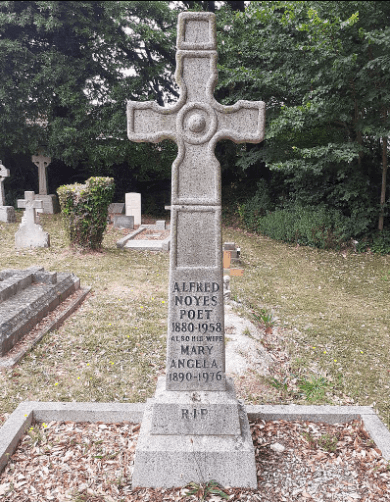
The Highwayman’s Tragedy — Critical Insights
The poem’s impact lies in its ability to evoke strong emotions and create a lasting impression. Its combination of romance, adventure, and tragedy strikes a chord with readers, drawing them into the world of the highwayman and Bess.
The poem’s vivid imagery and masterful storytelling make it a classic that has stood the test of time.
When compared to other narrative poems of its era, “The Highwayman” distinguishes itself with its unique blend of genres. While it embodies the romantic and tragic elements found in many poems of the time, it also incorporates the thrill of an adventure story. This fusion of genres sets it apart and contributes to its enduring popularity.
The interpretation of the poem’s ending and its symbolism has been a subject of discussion among readers and scholars. The highwayman’s death at the hands of the soldiers carries a sense of tragic inevitability. Some view it as a symbol of the price one must pay for love and honor.
Bess’s sacrifice to warn him, despite the tragic outcome, symbolizes her unwavering devotion. The poem’s ending serves as a reminder of the complexities of love and the sacrifices it may demand.
Did you know…
Time for a plot twist in Noyes’ life! So, after his first wife passed away, he was like, ‘You know what? I’m switching teams!’ and converted to Catholicism in 1927. Sometimes, life throws curveballs, and you find solace in unexpected places. 🙏😇🕊️
In terms of legacy, “The Highwayman” continues to be celebrated and adapted in various forms of media, including theater and music. Its enduring popularity attests to its timeless appeal. The poem’s themes of love, betrayal, and sacrifice resonate with readers of all ages, ensuring its place in the literary canon.
Contextual Background
Alfred Noyes, the poet behind this masterpiece, was a British writer born in 1880. His early exposure to the poetry of Alfred Lord Tennyson and his education at Oxford University greatly influenced his literary style. This classical education is evident in his use of vivid imagery and traditional forms, like the ballad, which he employed in “The Highwayman.”
Did you know…
Okay, here’s the scoop: as Noyes got older, his eyesight started playing peekaboo with him. But guess what? He wasn’t ready to retire from the writing game. Nope! He became the OG of dictation, churning out literary gold like a boss. Who needs 20/20 vision when you’ve got words to conquer, right?👓✍️📚
The historical context of highwaymen in literature also plays a significant role. Highwaymen were notorious figures in the 17th and 18th centuries, known for robbing travelers on remote roads. Their daring exploits and romanticized portrayals in literature made them fascinating subjects.
Authors like Noyes drew inspiration from these highwaymen tales to create thrilling narratives that combined elements of romance and danger. In “The Highwayman,” the character of the highwayman embodies the archetype of the dashing rogue with a code of honor.
The poem’s reception and adaptations over the years have contributed to its enduring legacy. Since its publication in 1906, “The Highwayman” has garnered widespread acclaim. It has been anthologized and recited in schools, cementing its place in literary education.
Moreover, the poem’s popularity led to adaptations in various forms, including radio dramas, stage productions, and even a musical by the rock band Loreena McKennitt. These adaptations demonstrate the enduring appeal of Noyes’ narrative and its ability to resonate with diverse audiences.
Did you know…
Time for the grand finale, folks! Alfred Noyes took his final bow in 1958 and now rests in peace in the Roman Catholic cemetery at Totland, Isle of Wight. But here’s the kicker: he didn’t just leave us with memories; he gifted the world a treasure trove of literary awesomeness that’ll keep us entertained for ages! 📖🎭🌟
In exploring “The Highwayman” by Alfred Noyes, I’ve discovered a captivating narrative poem that combines romance, tragedy, and adventure. Its unique blend of genres, vivid imagery, and enduring themes of love, betrayal, and sacrifice make it a timeless classic. The poem’s historical context and the influences of its author, Alfred Noyes, enrich its narrative.
Its reception and adaptations over the years highlight its enduring appeal as it continues to captivate readers and inspire various forms of art and performance. “The Highwayman” stands as a testament to the power of storytelling in poetry, reminding us of the profound impact literature can have on our hearts and minds.
Unearthing Hidden Gems: Noyes’ Lesser-Known Works and His Gift to Contemporary Readers
Poetry
The Loom of Years (1902) – His first volume of poems.
Significance: This debut collection introduced Noyes as a promising poet, showcasing his early talent for crafting vivid and emotive verses.
Quote: “Out of the loom of the stars, the Weaver of Years in the still, Weaves us for ever the web of the years that our hands cannot weave.”
“The Barrel-Organ” (from “Poems” – 1904) – A notable poem.
Significance: “The Barrel-Organ” is a celebrated poem, reflecting Noyes’ mastery of lyrical and evocative language.
Quote: “But the barrel-organ was ours, the hurdy-gurdy, And there in its resonant cave I would stand alone, With a ragged knife-board and a red-hatted monkey, And the wheel and the dancers would wake to a stormier tone.”
Biography
Voltaire (1936) – A biography.
Significance: Noyes’ exploration of Voltaire’s life offers readers a fascinating glimpse into the Enlightenment era and the mind of a renowned philosopher.
Quote: “He was the magician who invoked the Devil, and when the Devil came, as a wily black cat, he only laughed and threw a poker at him.”
Autobiography
Two Worlds for Memory (1953) – An autobiography.
Significance: This autobiographical work delves into Noyes’ own life, providing insights into his experiences and the events that shaped his literary career.
Quote: “For the world outside there was one book and one book only. And yet what a Book! A book without end, without a preface, a book that was a world, a book that was living breath!”
Novels
The Last Man (1940) – A novel.
Significance: Noyes’ foray into fiction, “The Last Man,” explores themes of isolation and survival, captivating readers with its gripping narrative.
Quote: “He was no longer afraid, but the fear remained in the world. It was a fear that filled the air.”
The Devil Takes A Holiday (1955) – A novel.
Significance: This novel presents an intriguing concept of the devil taking a vacation, offering readers a unique perspective on morality and human nature.
Quote: “And the Devil smiled, showing his teeth like the rocks of a desert.”
Children’s Literature
The Devil Takes A Holiday (1955) – A novel.
Significance: Noyes’ venture into children’s literature weaves an enchanting tale that appeals to young readers and the young at heart.
Quote: “The secret lay on Pooduck Island, and all the children knew it.”
Literary Criticism
Pageant of Letters (1940) – A work of criticism.
Significance: Noyes’ exploration of literary history and criticism provides valuable insights into the world of letters, making it an essential read for those interested in literature.
Quote: “In the great Pageant of Letters, where all of us walk, each shall pass by and be forgotten, leaving no print on the golden pavement.”
Epic
Drake (1906 and 1908) – A 200-page epic in blank verse about Sir Francis Drake, published in two volumes.
Significance: Noyes’ epic portrayal of Sir Francis Drake‘s adventures is a testament to his ability to bring historical figures to life through poetry.
Quote: “But the winds shall prevail, and the waves, and the thunder; And the ship of Drake shall stand up on the waters, Calm and splendid and tall, riding the billows, Like the glory of England herself on the perilous sea.”
In conclusion
“The Highwayman” by Alfred Noyes stands as a timeless masterpiece that continues to captivate readers and enthusiasts worldwide. With its haunting narrative, vivid imagery, and poetic prowess, this poem has left an indelible mark on the landscape of literature.
It’s a poetic journey that transcends time, whisking readers away to the shadowy world of highwaymen, star-crossed lovers, and tragic sacrifice. Alfred Noyes’ work invites you to explore the depths of human emotion and the enduring power of storytelling.
With every stanza and verse, “The Highwayman” invites you to delve deeper into its rich narrative and poetic excellence, making it an essential read for all who appreciate the beauty and depth of classic poetry.
